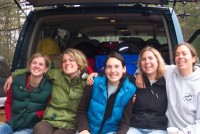07/31/2005, The Headwaters of the Meadowbank -- 64 Deg. 56 Min. North, 96 Deg. 33 Min. West

The day was a bright blue, sky and water alike, and the sentiment was powerfully good. Our days on the tundra were numbering somewhere in the 60s and we were feeling very well steeped in the tea of our travel. We had wished the mighty Dubawnt well, shaking hands with the Thelon River, looking forward to the 100+ mile traverse across Aberdeen and Shultz (the two largest lakes on the Thelon River). With long days and a little luck with the winds, the southeasterly kind, we'd reach the other side of the Thelon River in four or five days.
The lakes possessed a new energy, different from the previous waters. They were big, open, almost sea-like, but unlike Dubawnt Lake, we maintained sight of both the northern and southern shorelines, which offered a surprisingly intimate ambience. And oh yes, they were ice-free! It took us a minute and a few double-takes to recognize the lack of polar cap on our travel route. Even then we were not fully convinced that our ice age was over. It was only the third week in July after all. If there was ice, we didn't see it.
Recalling Aberdeen. As I quietly stern the blue-decked boat, my mind slips into recollection, melding our past days of water and tundra. The paddle stroke is therapeutic, the sun roses my cheeks, and I begin the internal dialogue. I wonder just how well we know these barren lands. We travel steadily through its winds, rain, ice and sun. We have an honest love for the land, reverence for the weather and cooperation with the bugs. We breathe northern air, drink arctic bound water and couldn't count the number of inexplicably majestic creatures we've encountered: musk oxen, arctic wolves, caribou, geese, cranes, ptarmigans, etc. I think we must be as tundraed as one could be. What more could this treeless expanse of rock, river and permafrost hold for us?
Another stroke of the paddle and we are out of Aberdeen entering Shultz. On top of a narrow esker-like peninsula that divides the lakes stand two towering inukshuks, reminding me of an entirely different history this land knows. Inukshuks are rock-piled, human-like pillars, made by the Inuit people who inhabited this land for centuries. Only 60 years ago, the Ihalmiut lived on the plains we are traveling. Their history is long, rich, yet disturbingly silent, even to those who seek to understand this place to its fullest. They were a people who lived with balance, as innate elements of their environment. They subsisted on caribou and lived nomadic lives; they were hunters, and wise women. We are surprised to be learning of their history for the first time, seeing that we are five college graduates who have already traveled in the Boreal forest and tundra. Are these people remembered? Who are their spokespersons? Where are their memories? The more we learn about the Ihalmiut and other Inuit groups (Crees, Chippewyan, Idthen, Eldeli), the more they become part of the world we are seeing.
Along with the Inukshuks we've encountered, the land is scattered with tent circles (rocks that fastened tents to the ground), uncovered caches (rock piles used to cover and store caribou bodies), inukoks (stone human forms signifying greetings) and several carins that mark traditional routes. Each of these rock forms churn more curiosity and reason to contemplate their age, builder and story.
Today marked the end of our second watershed from the Thelon to the headwaters of the Meadowbank River. To cross a watershed is to traverse the most suitable portaging route between two major water systems, ours being one of elevation skirting, dragging up nearly dry creeks and portaging over terrain of rock, shallow bog and hummocks. It is easy, almost natural, to imagine the Inuit people in this stretch. The Ihalmuit often traveled between the Dubawnt, Thelon and Back Rivers. They moved on foot in the summer and by dog sled in the winter. They hunted and traveled with very little baggage (a completely foreign concept to the Borealis crew) and moved with ease. Last week, when we traveled through the confluence of the Dubawnt and Thelon Rivers, we paddled by an ancient meeting place of Inuit groups from all over northern Canada. This "famous" spot is where the Ihalmuit and others met to trade goods of their land: copper, soft stone, stir, whale bone, wood, iron, and eventually the goods of the white man. This meeting place could have been just another hill on the horizon of horizons, but it came to life that day for us. Whether or not we will ever truly know the Inuit story or understand the nuances of their lives in these barren lands, our experience here is richer and we are better for learning what we have.
On a completely separate note, we'd like to thank Judy and Neil Yarian and Longs Drugs for donating over 100 rolls of film and for their services in processing it. You have contributed to one of the most important elements of the expedition and we are so appreciative for it. We'd also like to wish the Girls Session and Outpost at Manito-wish happy trails. We hope you have rocking trips in the woods and even better Pauline Bunyan breakfasts back at camp. Thank you again for staying tuned with us. We feel privileged to share our stories with such an audience.
P.S. To my four trip mates' fathers: I wanted to make an official note that each of my trip mates, Karen, Beth, Emily and Nina, caught impressively five fish back at Tukto Lodge. They just weren't as big as the 33 pound "Big Case Casey" and, yes, the competition is on.
View Photos CLICK HERE
Support the Borealis Campership Fund at Camp Manito-wish YMCA
